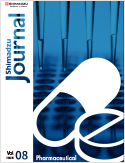Vol.8, Issue1-July 2020 CONTENT
Featuring Pharmaceutical
 |
Shimadzu Journal Vol.8, Issue1-July 2020 (15,211 KB) Pharmaceutical |
 |
[INSIGHT FROM CUSTOMER] Interview with Dr. Mirlinda Biba We interviewed Dr. Mirlinda Biba, a Principal Scientist in the Analytical R&D department at Merck in the United States. She has been working with Supercritical Fluid Chromatography (SFC) for almost 20 years. She is also a member of the Enabling Technologies Consortium (ETC) and joined the project to develop a new preparative SFC instrument. |
 |
[INSIGHT FROM CUSTOMER] Precompetitive collaborations focused on the development of new technologies for conducting pharmaceutical research and development are becoming increasingly popular. This article reports on one of the first development projects from the recently formed Enabling Technologies Consortium (ETC): the creation of a new instrument for carrying out mid-scale preparative supercritical fluid chromatography purifications. |
 |
[REPORT] In this study, methods were established for analysis of hydroxychloroquine sulfate and related substances following European Pharmacopoeia (EP10.0) and for determination of hydroxychloroquine sulfate content in tablets following US Pharmacopoeia(USP 43). Using a Shimadzu UHPLC system, excellent separation was achieved between hydroxychloroquine sulfate and impurity C, as well as between impurity B and impurity C referring to the EP assay. |
 |
Based on the conditions recorded in FDA documents, we developed a method for the analysis of NDMA in ranitidine drug substance and capsule preparations using the Shimadzu LCMS-8050 Liquid Chromatograph-Tandem Mass Spectrometer, and a method using the LCMS-9030 Q-TOF Mass Spectrometer for the reference of relevant testers.
|
 |
This study presents the development of three methods to detect NDMA in metformin using the Shimadzu LCMS-8050, GCMS-TQ8050 NX and GCMS-QP2020 NX, based on the recipe published by the National Institutes for Food and Drug Control and Health Sciences Authority of Singapore.
|
 |
This article introduces approaches to analyzing elemental impurities by ICP-MS or EDX-RF based on ICH Q3D (ICH:International Conference on Harmonisation of Technical Requirements for Registration of Pharmaceuticals for Human Use, Q3D: Guideline for Elemental Impurity).
|
 |
These article were selected by Shimadzu. Relating pharmaceutical analysis and development, they are from posters presented at ASMS 2019 and from application notes. They feature a variety of instruments we produce and include cutting-edge technologies. Please obtain the articles of your interest through the links on the titles.
|
 |
[LATEST TOPICS]
On November 14th, 2019, Shimadzu (Asia Pacific) hosted The Global Pharma Summit in Singapore. This was seventh chapter of the event, with theme of “Transforming the Future of Pharma”. The event brought 103 pharmaceutical industry leaders, health-care providers and researchers to Singapore from 20 countries around the world.
|
 |
[LATEST TOPICS] Shimadzu Scientific Instruments (SSI) and Northern Michigan University (NMU) have partnered to establish the Shimadzu Analytical Core Laboratory for Medicinal Plant Sciences. Through this collaboration, SSI has donated instrumentation for the laboratory to support NMU’s first-in-the-nation medicinal plant chemistry program. |
 |
[LATEST TOPICS]
Shimadzu Corporation (Shimadzu) and the Earle A. Chiles Research Institute, a division of Providence Cancer Institute (Providence) in Portland, Oregon, have entered into a joint research agreement to apply mass spectrometry technology to develop tools for personalized cancer immunotherapeutics.
|
 |
[LATEST TOPICS]
The year 2020 marks 50 years since the release of Shimadzu’s first mass spectrometry device, the LKB-9000. To celebrate this occasion, Shimadzu is planning a number of activities throughout the year. |
 |
[New Products] |



